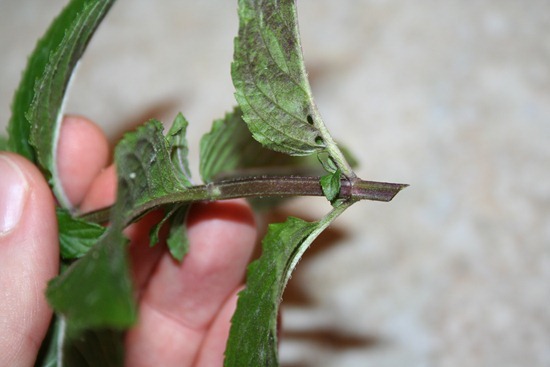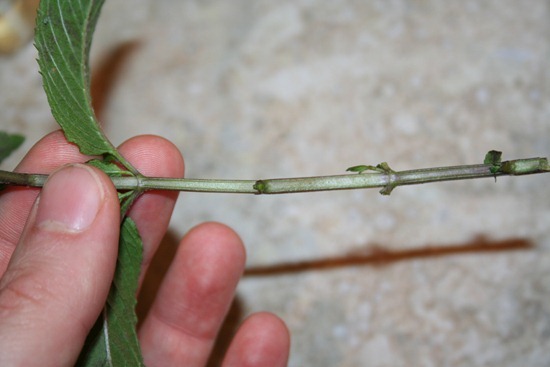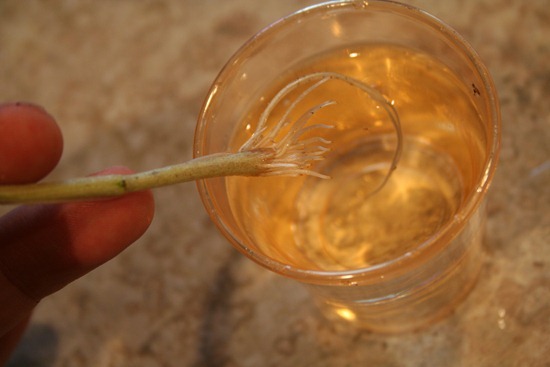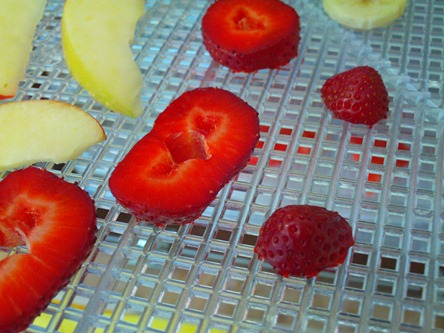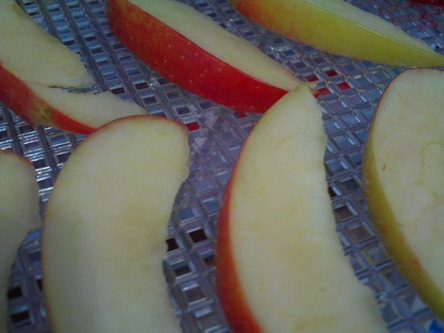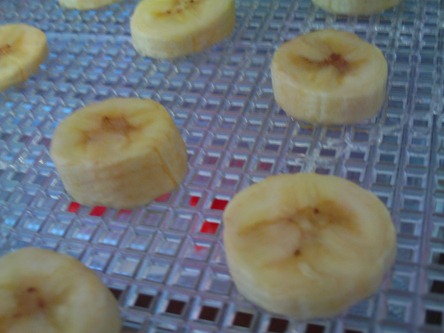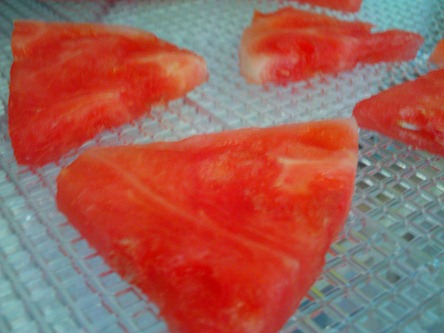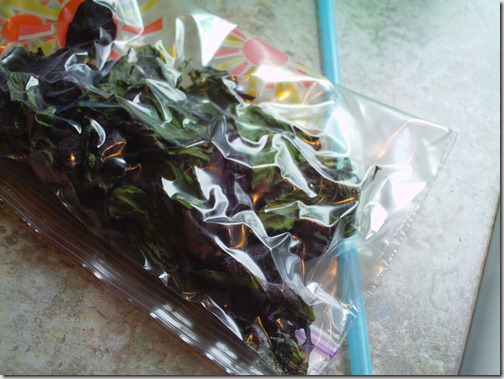Gift ideas for gardeners on your Christmas list
13.4 years ago garden planning, gardener, gifts
Maybe you are looking for something to add to your Christmas list or a fellow gardener you still need to buy for here are a few items on my list…let me know if anyone needs my address (smile).
 |
Have some on your list just starting out with gardening (or has been very unsuccessful in the past) how about the PlantSmart Digital Plant Care Sensor? You simply turn the device on and place it in your problem area for 24 hours and plug it into your computer and it will provide important info on temperature, humidity, and light intensity. Too see a full review of the EasyBloom (same product different name) here. |
 |
The Japanese Hori Hori Digging Tool is probably the most versatile tool you can get for your garden. It has a curved blade great for planting and weeding. The serrated blade can easily cut through small branches or break off a piece of twine two tie up some tomatoes or to take on some vengeance on pesky garden pests…but wait there is more flip it over and it even measure the depths of your planting holes to make sure you planted those bulbs deep enough. This is definitely a welcome addition to any gardeners stocking. |
 |
The AeroGarden with Gourmet Herb Seed Kit is a nice system to get your gardening loved one a way to use their cold green thumb during the wintertime. Using a special CFL bulbs and automatic timed watering using aeroponics you can have delicious herbs growing on your kitchen counter for easy use in your cooking. |
 |
Now the Felco F-2 Classic Manual Hand Pruner is a little more expensive than the ones you normally would find in your local home improvements store, but for a tool a gardener will use for many hours every season a quality tool like this can easily last a lifetime with minimal care. |
 |
Finally there is a little something for the little ones. The Kid’s Size 3 Piece Gardening Hand Tools |
Tags: garden, gifts, herb garden
How to make dried basil
13.8 years ago basil, dehydrator, herbs
Summer has finally appeared here in the Pacific Northwest with temperatures in the 90s I decided this would be a good time to dry some herbs in the garage given it was already at the right drying temperature without any heating required.
Here is the basic steps to harvest, dry, and store your own dried basil.
- 1. Pick and clean (optional) the leaves
- Start by trimming as much as you may need for the next month. If the leaves are dirty give them a quick rinse and pat them dry with a paper towel. If the leaves are clean you can skip this step. You want to pick the greenest leaves you can find. In my case many of the leaves were not as green as I would have likes (they are getting better now the weather is improving)
- 2. Strip the leaves from the stem
- Unlike oregano this part if very easy use scissors (or just pinch off with your finger nails.
- 3. Dry the leaves
- If you have a food dehydrator place the leaves in a single layer and set to 90-100 degree F for about 24 hours. Alternately you can also dry the leaves by placing them in a screen in a dry warm place. You will know they are down when the leaves are crispy and can be pulverized easily with your fingers.
- 4. Storing the leaves
- Now you have two choices:
- 1. Keep the leaves whole and chop them as you need them for added flavor
- 2. Chop them up using a spice/coffee grinder (or Magic Bullet
with the grinding blade) and use them immediately as needed
As you can see the freshly dried basil (left) looks much better than the stuff hanging around in my spice rack, which was only a few months old.
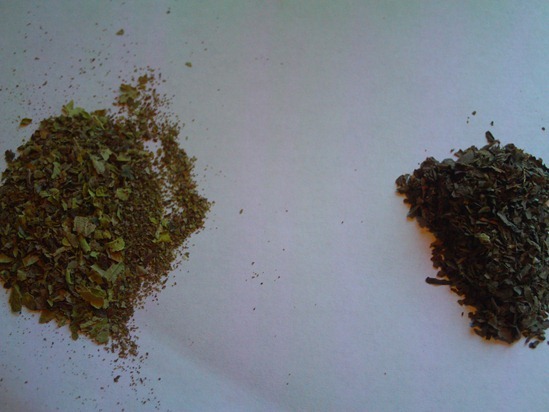
The picture above had two purposes, I actually place my herbs on paper then fold to easily pour into the old bottles.
Tags: herb garden, herbs
How to clone your own herbs in your garden
Cloning herbs is an inexpensive and fast way to expand your herb garden. This is also a great method to possible give or receive (with permission of course) from friends/neighbors.
Unlike cloning other organisms, plants have a much simpler procedure you can do in your kitchen.
1. Take cutting from mother plant. Cut a stem of total length of about 4-5 inches, cutting 1/2 inch above a leaf node. The leaf node is where the leaves attach to the stem. You want to make this cut at 45 degrees with a sharp knife/razor blade/shears.
2. Remove 2-3 sets of leaves. You want the plant to concentrate of growing roots rather than leaves so you need to trim off the sets of leaves that will be in water/rooting medium.
3. Start rooting process. You can apply a rooting hormone if you wish but I have had great results without needing to do this. Depending on the type of herbs you need to place your cutting in simply a container filled with water or some sort of rooting medium (Coir/Perlite/Coarse Sand/Rooter Plugs)
Herbs to start in water:
Basil, Thyme, Mint, Oregano
Herbs to start in Rooting Medium:
Lavender, Lemon Verbena, Lemon Balm, Rosemary, Sage, Santolina, Savory, Scented Geraniums, Stevia
Water Only Care. With the water only option you should change the water every couple days and ensure that the roots are always under water. You should see roots in a week to a week and a half. After the roots are well established you can then plant outdoors or to a 4 inch pot.
Rooting Medium Care. You will need to water the plants daily to ensure there is adequate moisture. After a couple weeks you should see that the cutting has a well established root system and can be transplanted to pot or outdoors.
Other ideas
I use this technique to save some money by purchasing a single plant at the my local garden center and then cloning to fill the space to get the harvest I am looking for. One other idea is to plant fresh herbs purchased from the grocery store, success may vary but should be fun to try…
This is also a great technique to extend your fresh basil throughout the winter. At the end of your outdoor season take a couple cuttings and place in water indoors. Use the fresh basil and when the plant appears to weaken take another cutting and repeat the process. Fresh basil all winter and a good basil plant ready for next spring.
Tags: herb garden, herbs
How to make dried oregano
This winter I went through my spice rack (which was given as a wedding gift 11 years ago) and threw out any spices I have yet to open and took inventory of spices I have at least used half of the container. These herbs were added to my growing list which one of which was oregano.
Here is the basic steps to harvest, dry, and store your own oregano:
- 1. Pick and clean (optional) the leaves
- Start by trimming as much as you may need for the next month. If the leaves are dirty give them a quick rinse and pat them dry with a paper towel. If the leaves are clean you can skip this step.
- 2. Strip the leaves from the stem
- You can try to save some time and plan on doing this after you dry but the stems will be come very brittle and will lead to a lot of tiny stem picking later. The easiest way to do this is to run your finger down the plant from the end of the stem toward the beginning that should get the leaves off pretty easily and quickly.
- 3. Dry the leaves
- If you have a food dehydrator place the leaves in a single layer and set to 90-100 degree F for about 24 hours. Alternately you can also dry the leaves by placing them in a screen in a dry warm place. You will know they are down when the leaves are crispy and can be pulverized easily with your fingers.
- 4. Storing the leaves
- Now you have two choices:
- 1. Keep the leaves whole and chop them as you need them for added flavor
- 2. Chop them up using a spice/coffee grinder and use them immediately as needed
As you can see the freshly dried oregano (left) looks much better than the stuff hanging around in my spice rack. Can’t tell from the picture but also smells much better too.
Tags: cheap, herb garden, oregano
More Fun with Food Dehydrator
14 years ago dehydrator, herbs, strawberries
I decided to be adventurous with the food dehydrator and grabbed some stuff from the refrigerator to make some nice nutritional snacks.
I started with some strawberries, the process is very simple, take some strawberries slice about 1/4 inch thick and place on the tray.
Next I moved on to apples which I soaked in a solution of lemon juice (about 1/4 cup) with 1 cup of water. To add a little extra sweetness I also dumped in a packet of artificial sweetener to reduce the sourness from lemon. After letting the apples soak in this solution for about 3 minutes I added them to the tray.
After slicing bananas about 1/4 inch thick I also soaked these in the same lemonade bath I did for the apples for 3 minutes as well.
Finally I spliced some watermelon at the same approximately 1/4 inch thickness while removing as many seeds as possible and then placing the slices on the trays and moving them into the dehydrator preheated at 100 degrees F.
After about 24 hours the apples were ready and very delicious, these did not last wrong. Next came the strawberries which tasted ok, but were very difficult and basically not worth the time to attempt to wedge from tray and eventually gave up a through most of these away. This was followed by the watermelon which wasn’t quite as messy and tasted like semisweet candy with a light watermelon flavor which seems about right since watermelon does not have nearly as strong a flavor naturally as you would get in artificially sweetened gum or candy. Lastly were the banana chips which were good and were all eaten though for the long time required to dry I probably will opt to buy the non-fried version of these at the store.
Overall it was fun to make these but apples will probably be the only ones in a future rotation but looking forward to drying some garlic, onions, and herbs later this year.
Tags: cheap, garden seeds, garlic bulbs, herb garden, strawberry plants, vegetables
Drying peppermint leaves
14 years ago dehydrator, herbs, peppermint
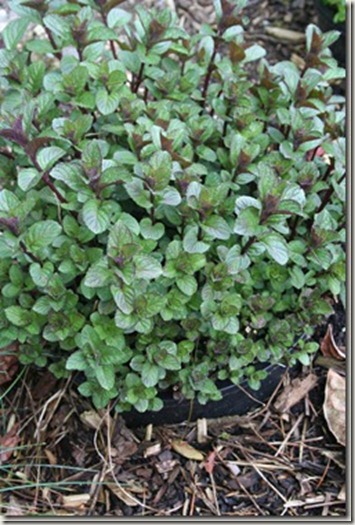
Excited to try out my new to me food dehydrator, I collected some peppermint leaves from my 2 year old peppermint plants which is fighting the confirms of the 1 gallon pot I have used to keep it from consuming my entire flowerbed, lawn, house, etc.
For the best potency, it is best to collect mint right before they start to flower and first thing in the morning when their oils are at their peak. Given it is a couple months before they will be flowering I picked them in the early afternoon.
If they were dirty you should wash them off and pat them dry with a paper towel and add directly to your dehydrator. In my case we had a rain the night before and they were very clean so I skipped the washing step.
Next I simply put them into the dehydrator at 100F degree and in a few hours later they were all crumbly and looked like what you see below.
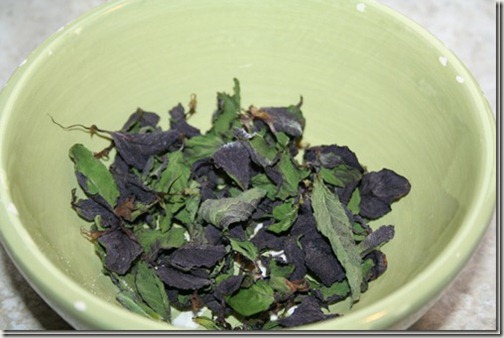
To store the leaves I went with the poor man’s vacuum packing technique…Ziploc bag and sucking the air out with a straw which should keep the herbs fresh for a few months.
Lastly I tried out the product by taking a pinch of the leaves and quickly breaking them up with my fingers and added them to a tea strainer.
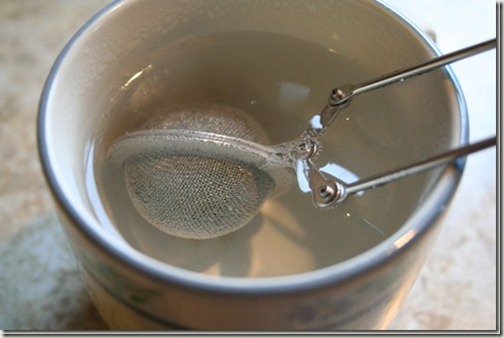
After a few minutes of steeping I had some good looking and tasting peppermint tea.
I would say my testing of my new dehydrator was a success…now off to see what else in the fridge I can dry out.
Tags: cheap, garden seeds, herb garden, outdoor plants, pepper plants, peppermint plant, vegetables

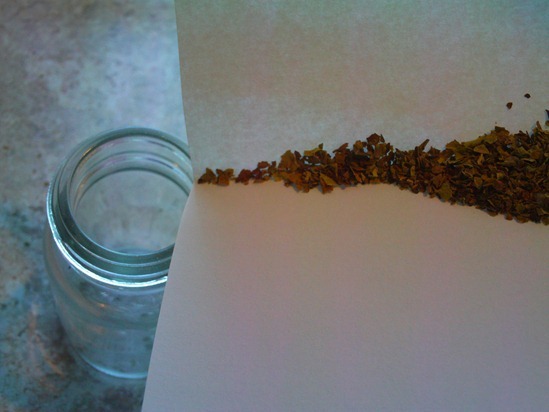
![003[1] 003[1]](http://www.cheapvegetablegardener.com/wp-content/uploads/2010/07/0031_thumb.jpg)
![032[6] 032[6]](http://www.cheapvegetablegardener.com/wp-content/uploads/2010/07/0326_thumb1.jpg)
